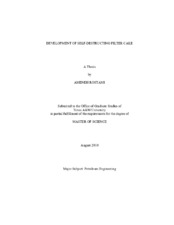Development of Self-destructing Filter Cake
Abstract
The main goal of drilling a horizontal well is to enhance productivity or injectory by placing a long distance drain-hole within the pay-zone. Poor drilling fluid design results in difficulties such as poor hole cleaning, excessive torque or drag, wellbore instability, stuck drill string, loss of circulation, subsurface pressure control, poor cement jobs, and difficulties associated with running electric logs and formation damage can result. Neither of the conventional chemical cleaning methods can overcome problems for filter-cake removal in long horizontal and maximum reservoir contact wells because of limitations such as the complex geometry of wells, non-uniform chemical distribution, low contact between cleaning fluids/filter cake, and high chemical reaction rate, especially at high temperatures.
This study describes a novel self-destructing drilling fluid system. Filter cakes are formed from a formula of drilling fluid that have a mixture of solid acid precursor and particulate solid acid-reactive materials. Then in the presence of water, the solid acid precursor (polylactic acid) hydrolyzes and dissolves, generating acids that then dissolve the solid acid-reactive materials (calcite). It effectively stimulates the horizontal section right after drilling and eliminates acidizing, resulting in significant cost savings, and improves filter-cake removal, thus enhancing the performance of the treated wells.
A series of experiments have been run in the lab to determine the efficiency of this new system. Properties of this drilling fluid are measured. Experiments on solid acid particle size showed that the best size-distribution of solid acid precursor and solid reactive material to make a self-destructing filter cake is fine particles of calcium carbonate used as weighting material with 150 microns polylactic acid as solid acid precursor. By comparison of the results of the experiments at different temperatures, 230 degrees F has been chosen as the best temperature for running experiments. The self-destructing drilling fluid systems need enough time for the solid acid to be hydrolyzed and therefore remove the filter cake. After 20 hours of contact with the water as the only cleaning solution, about 80 percent of the filter cake was removed. Calcite is found to be the dominant compound in the sample of remained filter cake, which was proved by x-ray diffraction tests. Secondary electron microscopy (SEM) results show the morphology of the remained filter cake sample and confirm the crystalline area of calcite.
Citation
Rostami, Ameneh (2010). Development of Self-destructing Filter Cake. Master's thesis, Texas A&M University. Available electronically from https : / /hdl .handle .net /1969 .1 /ETD -TAMU -2010 -08 -8366.


